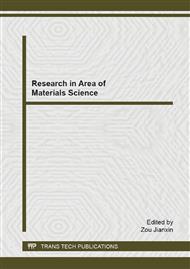[1]
X. J. Tang, Y. Bai, A. Duong, M. T. Smith, L. Y. Li, L. P. Zhang, Formaldehyde in China: Production, consumption, exposure levels, and health effects, Environ. Int. 35 (2009) 1210-1224.
DOI: 10.1016/j.envint.2009.06.002
Google Scholar
[2]
Z. Li, J. H. He, J. Zhang, Faile in-situ synthesis of manganese dioxide nanosheets on cellulose fibers and their application in oxidative decomposition of formaldehyde, J. Phys. Chem. C. 115 (2011) 16873-16878.
DOI: 10.1021/jp2050564
Google Scholar
[3]
Y. W. Lu, D. H. Wang, C. F. Ma, H. C. Yang, The effect of activated carbon adsorption on the photocatalytic removal of formaldehyde, Build. Environ. 45 (2010) 615–621.
DOI: 10.1016/j.buildenv.2009.07.019
Google Scholar
[4]
H. D. Gesser, I . E. Gesser, P. Wong, The Use of Reactive Coatings on Filters for the Removal of Indoor Gaseous Pollutants, Environ. Int. 18 (1992) 463 – 466.
DOI: 10.1016/0160-4120(92)90264-5
Google Scholar
[5]
H. Schmitz, U. Hilgers, M. Weidner, Assimilation and metabolism of formaldehyde by leaves appear unlikely to be of value for indoor air purification, Chin. J. Environ. Eng. 1 (2007) 104-106.
DOI: 10.1046/j.1469-8137.2000.00701.x
Google Scholar
[6]
L. F. Wang, Makoto Sakurai, Hideo Kameyama, Study of catalytic decomposition of formaldehyde on Pt/TiO2 alumite catalyst at ambient temperature, J. Hazard. Mater. 167 (2009) 399-405.
DOI: 10.1016/j.jhazmat.2008.12.129
Google Scholar
[7]
J. Yu, X. Li, Z. Xu, NaOH-Modified Ceramic Honeycomb with Enhanced Formaldehyde Adsorption and Removal Performance, Environ. Sci. Technol. 47 (2013) 9928-9933.
DOI: 10.1021/es4019892
Google Scholar
[8]
M. Katoh, T. Yoshikawa, T. Tomonari, Adsorption Characteristics of Ion-Exchanged ZSM-5 Zeolites for CO2/N2 Mixtures, J. Colloid Interface Sci. 226 (2000) 145-150.
DOI: 10.1006/jcis.2000.6795
Google Scholar
[9]
A. Orlov, J. Klinowski, Oxidation of volatile organic compounds on SBA-15 mesoporous molecular sieves modified with manganese, Chemosphere, 74 (2009) 344-348.
DOI: 10.1016/j.chemosphere.2008.08.049
Google Scholar
[10]
P. Liu, C. Long, H. M. Qian, Synthesis and application of a hydrophobic hypercrosslinked polymeric resin for removing VOCs from humid gas stream, Chin. Chem. Lett. 20 (2009) 492-495.
DOI: 10.1016/j.cclet.2008.11.019
Google Scholar
[11]
Z. Wang, J. S. Zhang, Characterization and performance evaluation of a full-scale activated carbon-based dynamic botanical air filtration system for improving indoor air quality, Build. Environ. 46 (2011) 758-768.
DOI: 10.1016/j.buildenv.2010.10.008
Google Scholar
[12]
D. Graham, Characterization of physical adsorption systems. III. The separate effects of pore size and surface acidity upon the adsorbent capacities of activated carbons, J. Phys. Chem. 59 (1955) 896-900.
DOI: 10.1021/j150531a022
Google Scholar
[13]
Y. Sekine, A. Nishimura, Removal of formaldehyde from indoor air by passive type air-cleaning materials, Atmos. Environ. 35 (2001) 2001-(2007).
DOI: 10.1016/s1352-2310(00)00465-9
Google Scholar
[14]
D. Richard D, M. L. Delgado Núñez, D. Schweich, Adsorption of complex phenolic compounds on active charcoal: Adsorption capacity and isotherms, Chem. Eng. J. 148 (2009) 1-7.
DOI: 10.1016/j.cej.2008.07.023
Google Scholar
[15]
M. Drikas M, M. Dixon M, Morran J, Removal of MIB and geosmin using granular activated carbon with and without MIEX pre-treatment, Water Res. 43 (2009) 5151-5159.
DOI: 10.1016/j.watres.2009.08.016
Google Scholar


